
Content Marketing in 2024 and the Future
Article Summary
In this article, the focus is on the evolution and significance of content marketing, especially in the IT domain. The modern audience's shift from being product-centric to solution-focused has given rise to "inbound marketing." This approach emphasizes attracting prospects rather than aggressively pursuing them. The article underscores that today's consumers are more interested in the problems a business can solve rather than the products they offer. This change has led brands to emphasize content marketing, which involves creating and promoting content that is both useful and entertaining to the target audience. The article also highlights the challenges tech marketers face, such as creating content that appeals to various roles within target organizations. The importance of understanding user intent, creating impactful content, and the growing significance of video content are also discussed. The article concludes by emphasizing the need for content promotion through both paid and organic distribution.
Welcome To This 10-Part Blog Series on Enterprise IT Content Marketing Fundamentals
In this series we will consider the following topics:
- Content marketing in 2024 and into the future.
- How content marketing complements all of marketing.
- Using outreach for content marketing.
- An introduction to Gorilla Guides.
- Developing a strong SEO Foundation.
- Catalyst to your sales success.
- The emergence and importance of thought leadership.
- Building attention-retaining drip campaigns.
- Gorilla Guides as content marketing vehicles.
- How to create exceptional content.
In This Article:
- Inbound vs. Outbound Marketing
- Mastering User Intent
- The Growing Importance of Video
🤫 PS: Looking for pricing on custom Tech content? Get a price list here
It seems like with every day that passes, consumers demand more and more from businesses. With so many players competing to capture the same market, you have to earn the attention of your prospects—not hijack it.
Today, people care less about the actual product that you pitch (and the dreams you gave up to turn it into a reality), and more about the problems that you can solve.

This shift from being self-obsessed to being solution-focused is what gave rise to the concept of “inbound marketing”—a methodology, illustrated in Figure 1, that focuses on drawing prospects toward business, instead of actively pursuing them using interruptive/outbound tactics.

As a wise woman once said: “Ain’t nobody got time for that.”
This is especially true in the IT sphere, where, on average, six to eight individuals are actively involved in the buying process (and buyers complete 60% of the process before they even approach a vendor).
Don’t get the wrong idea—outbound marketing tactics aren’t exactly dead. However, the modern audience certainly doesn’t appreciate them—especially if you’re pitching to enterprises.
As a result, brands are focusing more on pushing insightful, relevant, and creative content that grabs the attention of their audience and compels them to engage.
In other words, brands are focusing more on content marketing.
Content marketing is the art and science of creating and promoting content that your target audience finds useful and/or entertaining. While the underlying goals vary from strategy to strategy, content marketing, when executed properly, can boost brand awareness, drive conversions, facilitate customer advocacy, and most importantly, help you establish your company as a thought leader in its domain.
Did you know that 70% of 3,400 marketers surveyed by HubSpot are actively investing in content marketing in 2024? That’s just a small reflection of how popular content marketing has become over the years, resulting from changed consumer preferences and buying behaviors.
However, according to the Technology Content Marketing 2024 report by the Content Marketing Institute (CMI), for 59% of tech marketers, the biggest challenge was creating content that appealed to the multiple roles in target organizations.
The world of content marketing isn’t constant. Let’s have a look at where content marketing stands, how it has changed over the years, and what the future holds—especially for tech marketers.
Mastering User Intent to Create Impactful Content
Content marketing is a user-centric art. The way to go about achieving your business goals through it is to craft creative gems that provide something of value to your target audience.
And the only way to do that is by going all in on user intent.
As the name suggests, user intent is the motivation (or the reason) that drives a prospect to seek certain information. Content marketing boils down to providing something (other than your main products) that your audience actually cares about, such as educational content that provides them with solutions to existing pain points, new perspectives, or new approaches to try. This content can be delivered through anything from informative posts to free tools they can use.
The goal is to provide this “value” in a consistent manner that gradually builds up trust, eventually turning qualified prospects into paying customers, and ultimately, turning customers into brand advocates.
The important thing to remember is that it all begins by understanding what your audience wants.
In fact, according to CMI’s Technology Content Marketing report, 36% of marketers felt that better understanding or knowing their audience(s) was going to be one of their priorities for 2024, whereas 34% were going to prioritize capturing better data.
The end goal? This will help them focus on creating content centered on user intent, guiding buyers through the entire process, and converting them into loyal customers.
A typical IT vendor has to create content for multiple roles within the same prospect organization, with each role having a different intent (as illustrated in Figure 2).

As marketers, you need to ensure that you’re targeting these intents with different content assets, across different channels.
There are many ways you can collect data that will help you understand what your audience is looking for, ranging from utilizing certain online search tools (which you’ll learn more about later) to analyzing the conversations your prospects and customers have with your sales reps.
For now, let’s take a look at it from the perspective of a prospect looking up something on Google.
User Intent Is the Same As ‘Search Intent’
Over the years, search engine optimization evolved from being a set of activities focused on gaming search engine algorithms to becoming a science that’s focused on understanding user intent (or search intent, if you will). When a user types in a query on a search engine, they expect to receive results that match their intent (i.e., the actual motivation/reason behind typing in that query).
For example, a person searching for “what is hyperconverged infrastructure?” doesn’t want to see a page that sells hyperconverged infrastructure, or one that doesn’t properly define hyperconverged infrastructure.
Search engines are now more than capable of understanding the intent hidden behind different queries and displaying pages that are best-suited to answer them, based primarily on the actual content of the page (along with many other factors).
Therefore, even if you do sell hyperconverged infrastructure, for example, you have a great opportunity to capture attention by creating helpful content on how hyperconverged infrastructure differs from traditional infrastructure, the different types of hyperconverged infrastructure architecture, the kinds of questions to ask a hyperconverged infrastructure vendor, and so on. This will be much more effective than just trying to sell people a hyperconverged infrastructure solution.
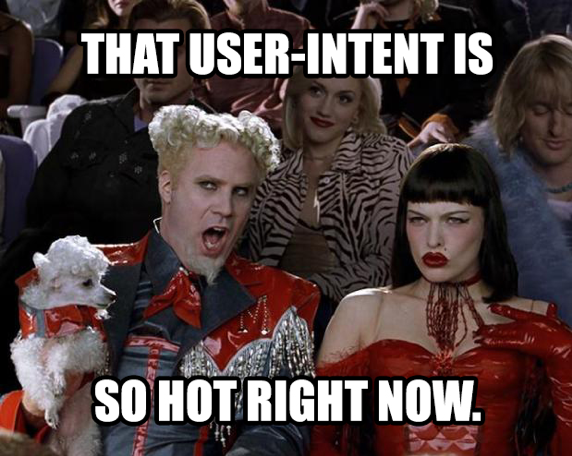
The 4 Main Types of Intent
To gain better clarity on intent and craft content that really hits the spot, search engine optimization specialists (folks who are experts at optimizing your online presence so that you show up higher in the results pages of Google and other search engines) classify search intent into the following categories:
- Informational: Queries with this intent are usually posed as questions, often beginning with “who, what, when, where, why, how.” The intent here is to find information for purely educational reasons. The ideal content that matches this intent should clearly answer the question(s) while keeping the user engaged. Users consuming informational content are usually at the very top of the marketing funnel. A Chief Technology Officer, for example, might type the query, “What is Kubernetes”?
- Navigational: Here, the intent is to help the user navigate to a desired location i.e., a webpage, such as a blog, a login page, and so on. Imagine someone searching for “Facebook” on Google (this is why they’re also sometimes referred to as “navigational brand queries”). As long as you own the brand, you’ll always show up first in the search results for your brand’s navigational queries. In our Kubernetes example, the query could simply be “Kubernetes” when the user is trying to navigate to The Linux Foundation’s website https://kubernetes.io/.
- Commercial: When there’s commercial intent behind a query, the user is currently in the process of evaluating different options in order to make a purchase. Or you can say that they’re in the Consideration phase of the marketing funnel. These queries usually include terms such as “reviews” or “best,” and so on. That being said, there is some overlap between informational and commercial intents, as the content that targets the latter also provides information and helps answer questions (the only difference here is how “qualified” the prospect is, as in, how much they already know and how “prepared” they are to convert into a paying customer). A sample search query might be “best container orchestration engine.”
- Transactional: When a user is ready to make a purchase, their intent is purely transactional. This is the final stage of user intent and signifies that they’re ready to convert. As a result, this content is usually referred to as bottom of the funnel. At this point, our fictional CTO might be searching for “Kubernetes demo from Vendor X.”
Have a look at Figure 3 to better understand where the different types of intent fit in the marketing funnel.
Understanding intent is the first of many steps that will allow you to create impactful content that takes the user to the next step of the funnel. Some brands are taking this to the next level by integrating a personal touch to their content. A classic example from our day-to-day lives is Netflix, which has an advanced algorithm that suggests TV shows and movies based on the user’s preferences.
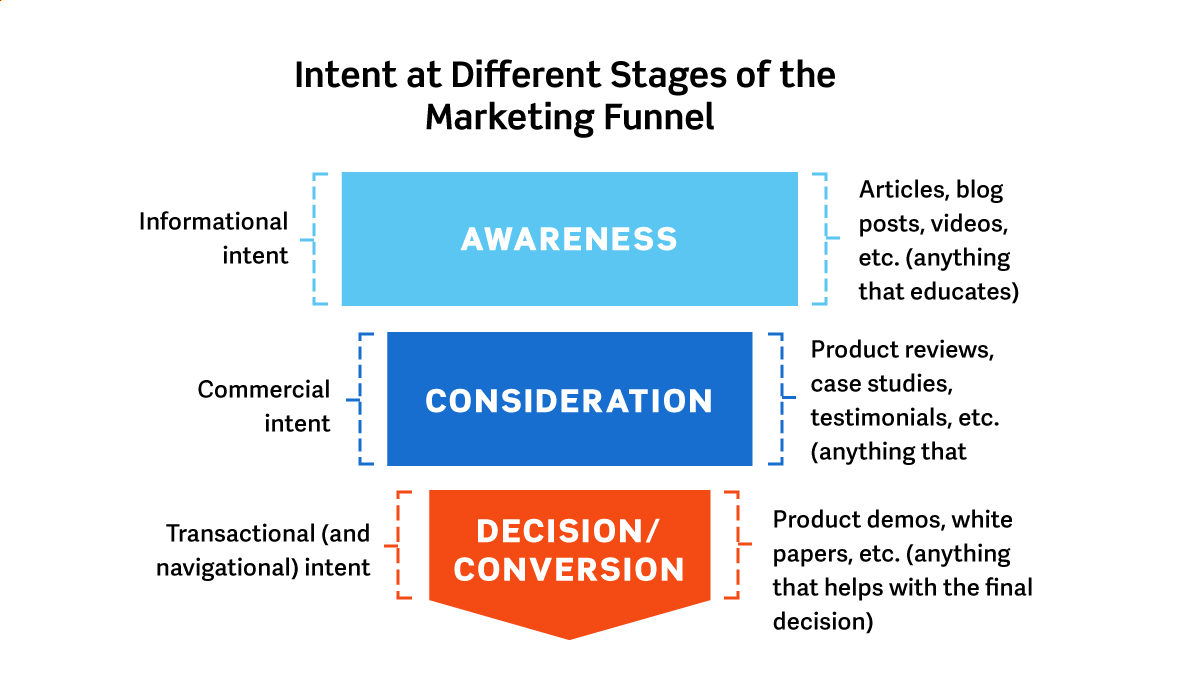
From a B2B tech marketing lens, this could mean anything from sending personalized emails triggered by how they interact with your website to offering custom solutions that suit their enterprise needs.
A “marketing funnel” is a theoretical journey that your customer takes from being a prospect (i.e. someone who fits your description of an “ideal customer”) to becoming a paying customer. This funnel can be mapped out graphically to help marketing and sales teams understand what messages to use at each stage.
While marketers use different variations and some marketers will argue that a new model is needed, a simplified version of the tried and true marketing funnel consists of the following three stages:
- Awareness: Also known as the “top of the funnel” (ToFu), the awareness stage is where a prospect identifies a need and seeks to be educated.
- Consideration: This is the intermediate stage, and therefore also known as the “middle of the funnel” (MoFu). At this stage, the prospect begins to evaluate different options that could help satisfy their need(s).
- Conversion/Decision: The last stage—or “bottom of the funnel” (BoFu)—is where the prospect chooses an option, makes the transaction, and converts into a paying customer.
Whatever the case, at the most basic level, mastering intent will help you come up with fresh and creative ideas for content.
Brainstorming for Idea- and Link-Driven Content Assets
Content creation is a never-ending struggle.
To stay relevant and maintain your brand’s position as a thought leader, you need to consistently create content that “wows” your target audience.
As you well know, that’s easier said than done.
Thanks to the wide-scale acceptance of smartphones and the ubiquity of faster Internet connections, we’re always exposed to some type of content. As a result, we tune lots of content out by default. In such a highly connected world, it’s difficult to cut through all the noise and be heard by your prospects.
The only way to do that is by coming up with unique ideas and topics to drive your content efforts.
According to CMI’s Technology Content Marketing report, 90% of tech marketers are using metrics like backlinks (the “linked” referrals that you get from third-party websites—more on this later), number of people who viewed your website, etc. to measure content performance in 2024.
This indicates that tech marketers—like everyone else—are also prioritizing link-driven content.
But the question is: how do you come up with content ideas that, when executed, are good enough to be “linked” to by others?
In other words, what could possibly motivate third parties to say “This content is great—you should definitely check it out!” to their own audience?
At the very least, your content ideas should tick the following boxes:
- They should result in assets that your target audience finds entertaining, educational, and engaging.
- The ideas should be relevant to your business and your offerings.
Again, it all starts by understanding the pain points of the user as they proceed from one stage of the customer journey to the next. This, in turn, will help you narrow down your focus and come up with a fresh idea for an asset that could help solve that problem.
Here are some tried-and-tested tips to come up with unique ideas:
- Begin by using keyword research tools to see what your prospects are actually searching for in the first place. Or better yet, talk to your sales personnel and ask them to share their conversations with your prospects and existing customers (like email chains). That way, you can find out exactly how your customers are describing their problems, what terminologies they are using for your niche/the solution you’re offering, etc. You can shortlist the most commonly repeated terminologies and questions, and work from there.
- Visit the blogs and social profiles of your competitors to see what they’ve been up to lately—it doesn’t hurt to seek a little inspiration from time to time. I mean, a little stalking never hurt anyone (just kidding, don’t be creepy).
- Check social platforms (especially LinkedIn, Reddit, Quora, and Twitter), to discover trending and relevant content that you can present in a better way or deliver a unique take on.
- Use web analytics tools to see how your audience interacts with your content. If an asset is bringing in a good amount of traffic, or a significant percentage of visitors are engaging with a certain part of your content, try to milk the topics and come up with related content pieces that deliver further value.
- Create a shared idea tank where you and your team members can conveniently add any unique ideas that you have throughout the day.
To establish a repeatable and scalable process, when a content asset performs well, you should analyze it to find out why, create your own “checklist” of best practices to help future assets perform well, and continue to build on the process as you discover more reasons why your content was successful. This way, you’ll be able to churn out high-ROI content on a consistent basis.
Additionally, your success will largely depend on how well you execute. For instance, there could be more than 10 different ways in in which you can discuss a problem and present its solution. The way you approach, package, and present it all will be the deciding factor in whether or not it performs.
Let’s say you’re crafting a blog post about ransomware. To make it stand out, go the extra mile and cover your topic from every angle (as in, understand the user intent behind the topic and provide insightful information on any question a reader may have on it); include helpful, engaging, and visually appealing infographics, videos, and GIFs; and link to any other relevant resources that might help the user dig even deeper.
The type of content that could be useful in this example include case studies of actual ransomware victims, dramatic statistics on what ransomware has cost companies in terms of lost data and revenue, and studies showing how quickly it’s exploded in the last several years.
Remember: educational, entertaining, and engaging. Yet, so many brands choose unoriginal, simple, and, unfortunately, boring. :-(
A safe way to ensure that your efforts gain traction over the long term is to focus on creating evergreen content. As the name suggests, evergreen content is any asset which remains relevant over time. Most of the content that we put out receives a stable flow of traffic for a few months (or even years), but then becomes obsolete and loses traction. This is one reason why it’s important to upgrade your best-performing content assets from time to time.
Evergreen Content Is a Link Magnet!
By publishing blog posts/articles centered on evergreen topics, you potentially set yourself up for a lifetime of stable website traffic. Since an evergreen content asset is unaffected by time, people will always look it up, making it highly linkable and a magnet for prospects for years to come.
Here are some great examples of evergreen content:
Cisco’s “What Is Cybersecurity?”: The content dives deep into the fairly basic topic of cybersecurity, discussing the main components and potential risks involved, making it a timeless asset. As of now, the content has over 1,800 backlinks and receives over 25,000 visitors every month.
Microsoft’s “What Is Cloud Computing?”: This is another classic example of an evergreen content asset on a basic topic. The article is actually a supporting asset for Microsoft Azure, yet the product is only mentioned once throughout the actual body, that too, as an example, making it an ideal educational resource. As of now, the page has over 1,400 backlinks and receives over 19,000 visits every month.
Built In’s “What Is Artificial Intelligence?”: With total backlinks exceeding 3,800 at the time of writing and an overwhelming monthly traffic of 63,000 visitors, this stands as one of the best-performing content assets on AI. The content provides a detailed explanation of how AI works, how it’s used, and takes the readers through a historical tour—the perfect recipe for evergreen content.
Great evergreen content, on the other hand, continues to receive traffic and backlinks indefinitely.
Considering the jaw-dropping potential that evergreen content packs, marketers are shifting their focus from creating a high volume of ephemeral assets to a slow, but steady creation of evergreen content that will stand the test of time. However, it’s not always easy to come up with topics or ideas that qualify as evergreen, which is why most brands end up producing generic content that doesn’t really get them anywhere.
If the topic, for instance, is network security, you could do a series on securing various cloud environments, including hybrid cloud, public cloud, and multi-cloud. The need for that information will not grow stale for a decade or more.
Gamifying Content with Videos and Interactive Elements
Over the years, video content has seen nothing but growth.
Even to this day, video continues to grow in popularity. In fact, according to HubSpot’s State of Video Marketing in 2024 report, 99% of marketers who create video content will continue to do so in 2024. And that statistic barely scratches the surface.
Check out Figure 4 for some more eye-opening figures.
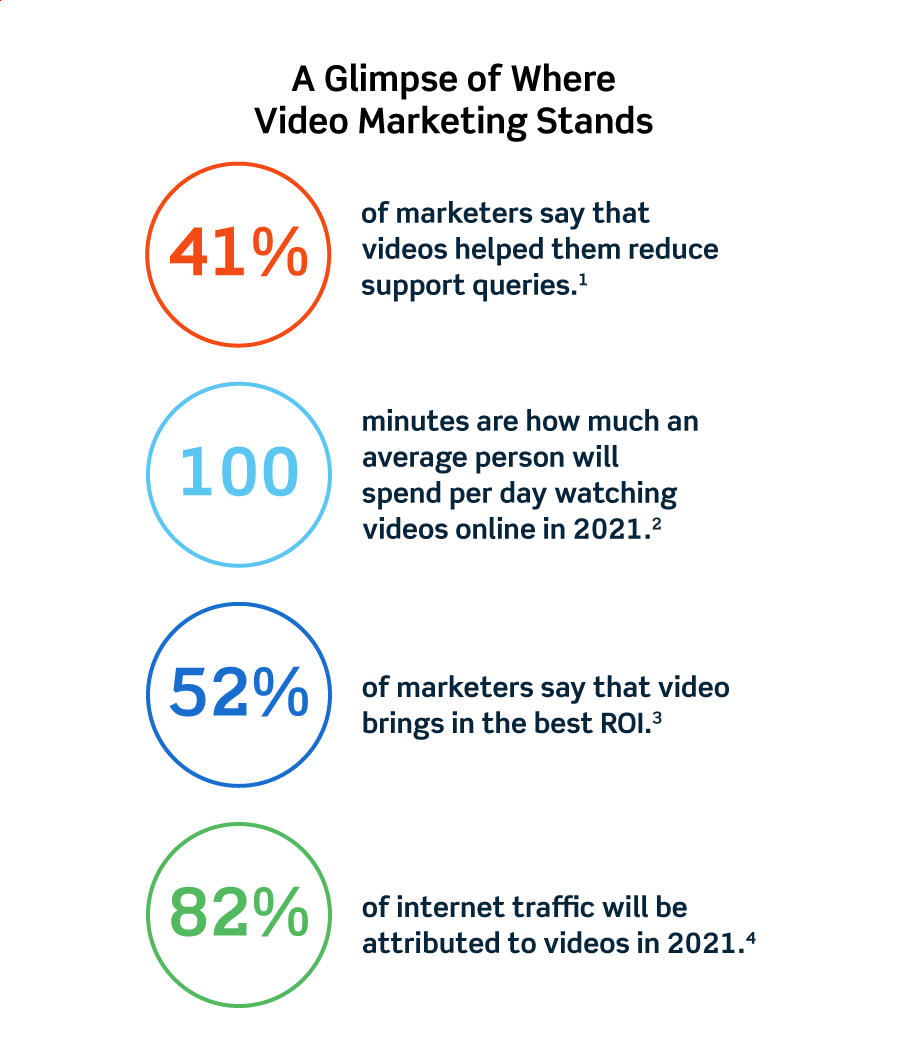
This is mostly due to the fact that we enjoy content that’s engaging, immersive, and requires minimum effort to consume—all of which you can easily accomplish with a video.
With great potential in terms of ROI, video remains as the most sought-after content format to date. In fact, some marketers no longer re-engineer written content to videos—it’s the other way around now. Video comes first.
As tech marketers, you should go all in on telling stories through your videos, and not pushing your brand too hard too soon (again, this goes back to the inbound mindset).
While we can’t tell you exactly how to create those videos or what formats to use (as it will vary from reader to reader and business to business), what we can do is advise you on the messaging: Empathize with the audience by showcasing a problem or making them aware of a hidden problem, and then show them exactly how to solve that problem (either through video case studies/testimonials, animated explainer videos, or any other format of your choice).
Enterprise IT industry practitioners are hungry for this kind of story given how quickly the cloud, containers, artificial intelligence, and other technologies are changing every aspect of business operations.
In addition to videos, marketers are also heavily investing in other visually appealing and immersive mediums. The two most popular formats include mini-games and interactive infographics (71% of marketers reported using infographics in the past 10 months according to CMI’s Technology Content Marketing report).
Optimizing Content for Users and Search Engines Simultaneously
We’ve already established that inbound marketing is purely user-centric. However, there’s definitely more to it than just creating content centered on user intent. Today, the secret sauce to nailing your marketing efforts is to also focus on user experience.
But what does user experience have to do with content? Everything.
The way you design, structure, and deliver your content can make or break your efforts. This mainly involves two factors:
How fast your content loads (53% of mobile users will abandon a website if it takes more than 3 seconds to load).
How visually appealing it is (about 75% of people will judge the credibility of your business by the design of your website, while 38%11 will stop engaging if the layout is unattractive).
That stings.
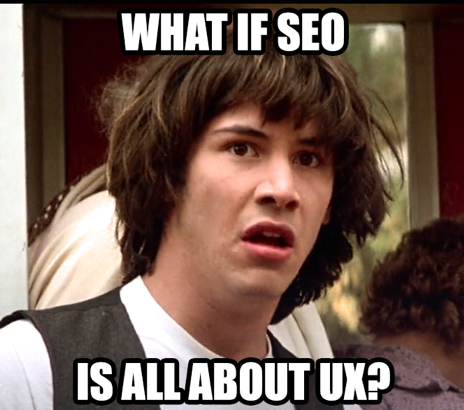
To create and deliver a positive and memorable user experience, marketers are prioritizing design, focusing on improving page speed (one of the many factors that search engines like Google use to rank pages in search results), and tracking user journeys on their websites to optimize layouts.
In fact, all of this is becoming mandatory from an SEO perspective, as search engines reward websites that provide valuable content, load fast, and keep users engaged.
By optimizing for user experience (UX), you’re also, in a way, optimizing for search engines. However, keep in mind that UX is just one essential component of SEO—all of which revolves around content.
Here are some actionable tips that you can start implementing today:
- Focus on search intent—create content that helps answer the questions that your prospects are asking.
- Improve the speed of your website—use compressed multimedia files (images, videos, GIFs, etc.) on your webpages. “Minify” the code by removing unnecessary whitespace and characters and compress them (you can seek help from a developer for this or install a plugin, such as Hummingbird on WordPress).
- Link to relevant pages/content—make sure to link out to any other sources (whether on your own website or an external channel) that you feel are relevant and could provide more value to your users.
- Use captivating visuals—incorporate eye-catching designs to all of the content assets that you use.
- Optimize for mobile—make sure that your website is properly optimized for mobile phones and tablets. This includes making CTA buttons bigger or smaller (find a balance between making them easy to tap but not too big as to result in accidental clicks), using responsive design (design that adjusts according to the size of a user’s screen), redesigning pop ups for mobile screens, and making sure all text on screen is easy to read.
Promoting Your Content to Infinity and Beyond
You can’t just create content, hit publish, and be done with it. That’s like inviting a bunch of people to a dinner party, cooking up a mean meal everyone will love and devour, and then leaving it in the kitchen.
After going through all the trouble of crafting content, you need to make some active efforts to kick things off and get people consuming. That’s where content promotion with both paid and organic distribution comes in.
Promotion is an essential piece of the content marketing puzzle. You can’t just rely on search engines alone to bring in traffic, after all. Tapping into additional channels—such as social media, email campaigns, and content syndication partners—gives your content a boost and can work wonders in terms of attracting qualified leads. Figure 5 lists different content promotion tactics.
Remember that promotion doesn’t necessarily have to betray the essence of inbound. This means that you can promote your content without being interruptive—as long as the people to whom you’re pitching care about it (again, this goes back to user intent).
Let’s talk about a few of the best content promotion tactics that should work for most brands.
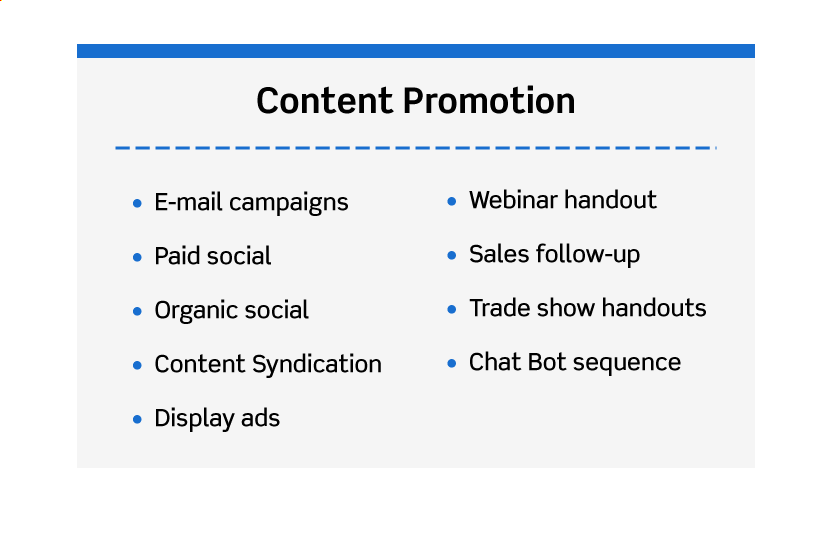
Content Syndication
Even if you publish high-quality content online—keeping all of the best-practices in mind—there’s no guarantee that it will perform just as good as you had originally hoped for without a little help. One tactic to instantly gain traction is content syndication.
Content syndication refers to publishing the same piece of content (usually an article or a guide) to other websites and databases. As an added bonus to syndication, you may also receive a backlink and a mention on that article, resulting in increased awareness, an influx of web traffic, and new leads.
Don’t confuse “content syndication” with “guest posting.” While the basic concept is the same—i.e. posting your content on other websites—there’s a key difference when it comes to the actual “substance.”
With content syndication, you essentially “republish” existing content on other platforms (while also clearly stating that the content was originally published on your website), whereas with guest posting, you craft an original asset from scratch to be posted solely on another platform under your name. The intended outcomes and level of effort are different.
This is a win-win situation. The platform where your content is “syndicated” leverages your content to attract traffic, and you leverage the popularity of that platform to increase your visibility.
Some content syndication partners like ActualTech Media guarantee results. When you syndicate high-quality content with our audience, we promise you a minimum number of fresh leads.
Content Re-purposing
If you have some high-performing content assets (be it blog posts, an e-book, or even a printed guide), why not tweak or reuse it to reach your target audience through other channels? That’s where content repurposing comes in.
Content repurposing refers to changing some or all elements of a content asset and using it on a different channel in the appropriate format.
For example, if you have an in-depth guide to digital transformation, you can “repurpose” it into a video (or even multiple short videos) that you can use during presentations, conferences, and trade shows. You can also upload the video(s) to YouTube and other social networks and use those clips to drive traffic to the landing page to download the full guide.
Distributing Content on Social Media
You’d be missing a big opportunity if you neglect social media channels today. Select the appropriate platforms that your target audience is active on (for most B2B marketers, the go-to platform is LinkedIn), and determine the ideal times to share content, along with a proper frequency.
Write insightful posts, abiding by the customs on that social network, that provide a glimpse of what your content is about—insightful enough to get the attention of your audience, and suspenseful enough to make them click (what IT pro wouldn’t click on the headline “The 5 Biggest Backup/Disaster Recovery Mistakes You’re Probably Making,” for instance?). If organic reach is limited, leverage paid ads, but make sure to target the right audience.
Reaching out to Other Content Publishers
This tactic involves actively seeking out content publishers/other blog owners who share the same or a similar audience as yours and proposing that they share your content (which will be valuable to your audience).
Obviously if they’re going to give you access to their audience, you need to come forward with something super valuable.
To Summarize
The 2020s certainly have exciting things in store for content marketers in IT.
To summarize, the content marketing success for B2B technology companies in 2024 (and the near future) will revolve around:
- Going all in on understanding user intent
- Coming up with exciting content ideas and executing them in a way that helps build backlinks, memorable experiences, more traction, and higher visibility
- Incorporating video/Increasing the use of video and other captivating visual assets to your strategy
- Proper optimization of web content for both users and search engines
- Promoting your content across a variety of channels to maximize your ROI
Now that you understand how prevalent content marketing has become and what best-practices are being followed in the industry, let’s take a look at how it fits into the whole marketing puzzle. In our next article in this series, we'll discuss: How content marketing complements all of marketing.